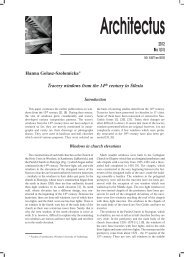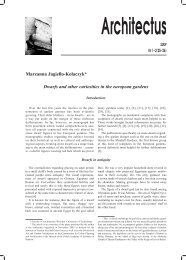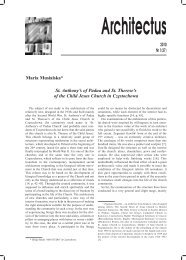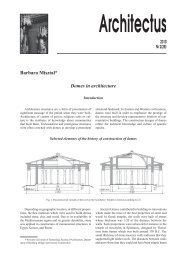Bernát Bérczi O. Cist.* The ruins and reconstruction of ... - Architectus
Bernát Bérczi O. Cist.* The ruins and reconstruction of ... - Architectus
Bernát Bérczi O. Cist.* The ruins and reconstruction of ... - Architectus
You also want an ePaper? Increase the reach of your titles
YUMPU automatically turns print PDFs into web optimized ePapers that Google loves.
12 <strong>Bernát</strong> <strong>Bérczi</strong> O. <strong>Cist</strong>.<br />
gers 38 broke through a foundation wall about 2 m thick<br />
<strong>and</strong> 1 m high – according to the account <strong>of</strong> the archaeologist<br />
Miklós Héjj – “the marks <strong>of</strong> the church’s western<br />
outer foundation wall”. If we accept that in 1952 they discovered<br />
the bases <strong>of</strong> the western outer wall – that<br />
Hümpfner could not find in 1912 – then we must imagine<br />
the church having only six bays, but then the street <strong>of</strong> lay<br />
brothers would lead into the open <strong>and</strong> not into the church.<br />
This is unusual but not impossible. Miklós Héjj in 1952<br />
may not have known <strong>of</strong> Hümpfner’s discoveries <strong>of</strong> 1912,<br />
the results <strong>of</strong> which were published in 1964. It is possible<br />
that they discovered the foundations <strong>of</strong> the last northwestern<br />
pier, if only a 2×2 metres section <strong>of</strong> it was seen,<br />
or, in the event <strong>of</strong> a continuous foundation wall, a section<br />
<strong>of</strong> the underground strip between the foundation <strong>of</strong> the<br />
piers. <strong>The</strong> question cannot be solved at present – perhaps<br />
Miklós Héjj himself had made a hasty judgement – so on<br />
the revised plans <strong>of</strong> Hümpfner I have marked it as possible<br />
– just as Hümpfner himself had done – on the western<br />
façade beyond the seventh bay.<br />
During the above mentioned excavations on a 15–20<br />
metre section the foundations <strong>of</strong> the northern wall <strong>of</strong> the<br />
church were also found. At the northern side-isle under<br />
the ground floor they found graves with sceletons <strong>and</strong><br />
a red marble column capital about 20 cm high, but this<br />
was broken to pieces the following night by unknown<br />
persons, <strong>and</strong> so the workers buried it in the ditch later.<br />
<strong>The</strong> laying <strong>of</strong> the watersupply pipes was continued in<br />
1954 at the place <strong>of</strong> the northern side-isle <strong>of</strong> the medieval<br />
church, <strong>and</strong> onward in a line east <strong>of</strong> the currently st<strong>and</strong>ing<br />
38 Veszprémi Laczkó Dezsõ Múzeum, Régészeti Adattár, no. 8806.<br />
Archaeological report <strong>of</strong> Miklós Héjj.<br />
At the beginning <strong>of</strong> the 1990s during a walk-around,<br />
two smaller fragments were found at a house in Zirc.<br />
<strong>The</strong>se were taken to the Archaeological Institute <strong>of</strong> the<br />
Eötvös Loránd University <strong>of</strong> Science. As promised, these<br />
should find their way into the stone repository <strong>of</strong> Zirc<br />
when it is established. During the last year these were<br />
returned to Zirc <strong>and</strong> placed into the stone storage room <strong>of</strong><br />
the monastery.<br />
In 1995 on the first floor <strong>of</strong> the Abbey building, which<br />
was built prior to 1735, during alterations, chiselled<br />
stones from the medieval monastery were found.<br />
In 1996 we opened a door into the cloister at the<br />
south-west corner <strong>of</strong> the present Abbey church. Several<br />
carved stone pieces were found during the breaking up<br />
<strong>of</strong> the wall. In the Baroque wall carved stones were<br />
embedded in mortar between two brick walls. At the<br />
opened up base <strong>of</strong> the church wall to about a 70 cm<br />
height we found chiselled stones <strong>and</strong> ashlars that were<br />
turned inward. Most important among the finds are:<br />
a fragment <strong>of</strong> the pier abacus <strong>of</strong> the medieval church,<br />
stringcourse <strong>and</strong> arches.<br />
<strong>The</strong> most recent finds<br />
pier. Here they discovered new graves <strong>and</strong> the exceedingly<br />
massive wall 39 that Tibor Hümpfner knew. <strong>The</strong> walls<br />
continued under the road even at a depth <strong>of</strong> 2 m.<br />
<strong>The</strong> following finds <strong>of</strong> 1972 did not come from the<br />
immediate vicinity <strong>of</strong> the Abbey grounds, but during the<br />
dismantling <strong>of</strong> the forrester’s house 40. <strong>The</strong>se stones that<br />
originate from the old monastery can also be found in the<br />
stone storage depot <strong>of</strong> the Valley <strong>of</strong> Veszprém.<br />
<strong>The</strong> last time that excavations around the medieval<br />
church took place was 1996 when gas supply pipes were<br />
laid 41. <strong>The</strong> northern side <strong>of</strong> the main road No. 82, <strong>and</strong> on<br />
its south side immediately east <strong>of</strong> the pier, a 45 metre<br />
length <strong>of</strong> the grassy strip between the main road <strong>and</strong> the<br />
pavement were opened up. On the south side <strong>of</strong> the road,<br />
about 7 <strong>and</strong> 12 metres east <strong>of</strong> the pier, those foundation<br />
walls were discovered which had been seen in 1912 <strong>and</strong><br />
1954. On the north side they thought that they had found<br />
the continuation <strong>of</strong> the wall that is 12 metres from the<br />
pier. On the south side <strong>of</strong> the main road, beside the wall<br />
<strong>of</strong> the arboratum, they dug up the entire length <strong>of</strong> the<br />
pavement <strong>and</strong> human bones were found at 37, 40 <strong>and</strong> 45<br />
metre distances. According to this the graveyard <strong>of</strong> the<br />
monks was east <strong>of</strong> the sanctuary <strong>of</strong> the church. At a distance<br />
<strong>of</strong> 14.5 metres from the pier a 100×60×30 cm large<br />
white carved limestone block was found. This was taken<br />
to Felsõõrs, to the stone repository <strong>of</strong> the Dezsõ Laczkó<br />
Museum <strong>of</strong> Veszprém.<br />
39 Veszprémi Laczkó Dezsõ Múzeum, Régészeti Adattár, no. 8807.<br />
Archaeological report by Dr Ákos Kiss.<br />
40 Veszprémi Laczkó Dezsõ Múzeum, Régészeti Adattár, no.<br />
15810 (8805). Archaeological report Sylvia Palágy.<br />
41 Veszprémi Laczkó Dezsõ Múzeum, Régészeti Adattár, no.<br />
18861–18897 <strong>and</strong> 18861–18899. Arch. Report <strong>of</strong> Pál Rainer.<br />
In the summer <strong>of</strong> 2004 in the area <strong>of</strong> the arboratum,<br />
about 35 metres east-south/east <strong>of</strong> the eastern wing <strong>of</strong> the<br />
medieval monastery, during the laying <strong>of</strong> sewerage pipes<br />
a fragment <strong>of</strong> the outer crocket stringcourse was found.<br />
Based on the place <strong>and</strong> form <strong>of</strong> the discovery, it is probable<br />
that it was a part <strong>of</strong> the south façade <strong>of</strong> the eastern<br />
wing <strong>of</strong> the monastery. This construction piece weighed<br />
several hundred kilograms. Furthermore, the building<br />
layer from the 12–13 th century <strong>and</strong> debris from the work<br />
<strong>of</strong> chiselling was also found.<br />
Early in September 2005 town residents reported to<br />
the Abbey as well as to the Cultural Heritage Protection<br />
Office that some 40–50 pieces <strong>of</strong> chiselled stone were<br />
found during demolition <strong>of</strong> a building 42 that stood at the<br />
inner corner <strong>of</strong> the bend <strong>of</strong> the main road No. 82 heading<br />
42 This building is presumed to be the mill about which Konstantin<br />
Horváth writes at the place marked below (“in 1728 below the <strong>ruins</strong><br />
<strong>of</strong> the old monastery”) <strong>and</strong> the h<strong>and</strong>-written map <strong>of</strong> Zirc <strong>of</strong> 1766 also<br />
marks it. – Horváth Konstantin O. <strong>Cist</strong>., op. cit., 169–172. – <strong>The</strong> map<br />
can be found in the Veszprém Megyei Levéltár VeML T no. 112.






